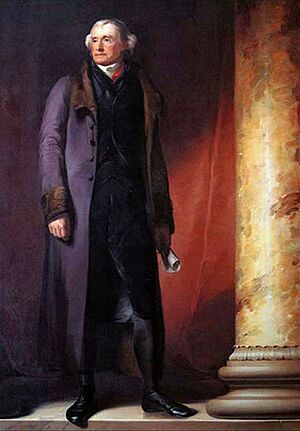Military Peace Establishment Act facts for kids
The Military Peace Establishment Act was a very important law for the United States military. It set new rules and limits for the army. President Thomas Jefferson signed this Act into law on March 16, 1802. He played a big part in creating it.
This Act had 29 sections. It explained how many officers and soldiers the military could have. It also covered how the army would get its supplies. A key part of the Act was creating a special group of engineers. These engineers would be based at West Point in New York. This place would become the Military Academy, also known as West Point. Its main job was to train skilled American engineers. This way, the U.S. would not need to hire engineers from other countries. President Jefferson also had political reasons for wanting this Act.
Contents
Why the Act Was Created
When Thomas Jefferson became president in 1801, he thought the U.S. military was too big. He also felt that many officers were from the Federalist party, which was his political rival. Plus, the army did not have its own group of engineers.
Jefferson wanted to make the army smaller. He also believed the military needed to train its own engineers. These engineers would work at a new military school. Ideas for a military academy had been discussed before. Leaders like George Washington and Alexander Hamilton talked about it during the American Revolution. At first, Jefferson did not agree with Hamilton. Hamilton thought the federal government should control such a school. But as president, Jefferson changed his mind. He saw the need for a national military academy run by the government.

As Secretary of War under Jefferson, Dearborn helped draft the Military Peace Establishment Act.
Jefferson always believed that "useful sciences" were important. He thought they would help protect the young nation. In December 1800, Jefferson worked with Henry Dearborn, who was the Secretary of War. They decided the army should have only one group of artillery soldiers and two groups of infantry soldiers.
Jefferson also asked for advice from Pierre Samuel du Pont de Nemours. He asked what kinds of science should be taught at a military academy. Du Pont suggested a big plan for national education. It included primary schools, colleges, and special schools for medicine, mining, and social science. He stressed the importance of math and science. Both Jefferson and du Pont felt that a military academy would greatly help the country. Du Pont wrote to Jefferson, saying, "No nation is in such need of canals as the United States, and most of their ports have no means of exterior defense." This showed the need for trained engineers.
West Point is Established
Two months after Jefferson became president, Secretary Dearborn announced big news. The president had decided to immediately set up a military school at West Point. Major Jonathan Williams, who was Benjamin Franklin's grandnephew, was chosen to lead the new school. He was told to prepare everything for the school to open.
Superintendent Williams said that their goal was not just a small math school. It was to be a "great national establishment." He believed that future officers needed to be "men of science." They should be so skilled that learned societies would notice them.
On March 1, 1802, Congress gave President Jefferson permission to create a corps of engineers. After Jefferson signed the Military Peace Establishment Act on March 16, the United States Military Academy quickly opened. It was located on the Hudson River in New York. The school officially began teaching on July 4, 1802.
Changes to the Army
At first, it seemed like Jefferson's Act would greatly reduce the army's size. But it actually led to only a few soldiers being removed. Instead, Jefferson and Dearborn focused on removing officers who were strong supporters of the Federalist party. Many of these officers had been appointed by the previous president, John Adams.
When Jefferson took office, the army had four infantry groups and two groups of engineers and artillery. There were 5,438 officers and men. After June 1, 1802, the new army had only two infantry groups, one artillery group, and a small Corps of Engineers. Jefferson's Act cut the number of officers by about one-third. The total army size became 3,289.
Jefferson had wanted to get rid of the standing army and navy completely. But after warnings from Federalists, he only made small cuts. He told Treasury Secretary Albert Gallatin to spend no more than $2 million each year. This money was to be split evenly between the army and the navy. Republican lawmakers believed this reorganization would save a lot of money.
The Act also created military agencies. These agencies replaced the old quartermaster's department. On April 27, Jefferson chose three people with good service records to lead these agencies. The Senate quickly approved them. These agents were in charge of buying and managing military supplies. They also handled hospital supplies for the army and goods for Native American payments. At each military post, an army officer would help the military agent.
Political Goals
Jefferson also had political reasons for proposing this Act. He wanted more military members who supported Republican ideas. His goal was not just to make the military smaller. He also wanted to remove "detractors" and those whose loyalty he questioned. He aimed to reform the government by replacing Federalist officers who controlled the army.
Jefferson worried that the military was becoming an elite group. He thought it was starting to act like the Society of the Cincinnati from the Revolutionary War. He believed the Military Peace Establishment Act would stop this from happening. With a smaller federal military, Jefferson thought that the various state militias should take on more responsibility for national security.
Images for kids
-
Thomas Jefferson
Portrait by Thomas Sully hanging in West Point -
Henry Dearborn
As Secretary of War under Jefferson, Dearborn helped draft the Military Peace Establishment Act.




